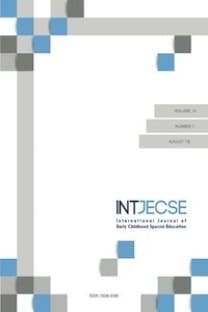Social constructivism and play of children with autism for inclusive early childhood.
inclusion, play, play interactions, autism spectrum disorder, early childhood education
___
Broadhead, P. (2004). Early years play and learning: Developing social skills and cooperation. London: Routledge Falmer.Brown, W., Odom, S., Li, S., & Zercher, C. (1999). Ecobehavioral assessment in early childhood programs: A portrait of preschool inclusion. Journal of Special Education, 33, 138-153.
Brown, M. and Bergen, D. (2002). Play and social interaction of children with disabilities at learning/activity centers in an inclusive preschool. Journal of Research in Childhood Education, 17-1, 26-37.
Brown, W., Odom, S., & Conroy, M. (2001). An intervention hierarchy for promoting young children’s peer interactions in natural environments. Topics in Early Childhood Special Education, 21, 162-175.
Buysse, V., Goldman, B., & Skinner, M. (2003). Friendship formation in inclusive early childhood classrooms: What is the teacher’s role? Early Childhood Research Quarterly, 18, 485-501.
Early childhood inclusion: A joint position statement of the division for early childhood (DEC) and the national association for the education of young children (NAEYC). Chapel Hill: University of North Carolina, FPG Child Development Institute.
Erwin, E., Alimaras, E., & Price, N. (1999). A qualitative study of social dynamics in an inclusive preschool. Journal of Research in Childhood Education, 14, 56-67.
Essa, E. (2011). Introduction to early childhood education. Belmont, California: Wadsworth Cengage Learning.
Frost, J., Wortham, S., and Reifel, S. (2012). Play and Child Development, 4th ed. New Jersey: Pearson Education, Inc.
Garfinkle, A. & Schwartz, I. (2002). Peer imitation: Increasing social interactions in children with autism and other developmental disabilities in inclusive preschool classrooms. Topics in Early Childhood Special Education, 22, 26-38.
Guralnick, M. (1993). Developmentally appropriate practice in the assessment and intervention of children’s peer relations. Topics in Early Childhood Special Education, 13, 344-371.
Guralnick, M., Connor, R., & Johnson, C. (2011). The peer social networks of young children with Down Syndrome in classroom programmes. Journal of Applied Research in Intellectual Disabilities, 24, 310-321.
Guralnick, M. & Groom, J. (1987). The peer relations of mildly delayed and nonhandicapped preschool children in mainstreamed playgroups. Child Development, 58, 1556-1572.
Guralnick, M., Hammond, M., Connor, R., & Neville, B. (2006). Stability, change, and correlates of the peer relationships of young children with mild developmental delays. Child Development, 77, 312-324.
Hestenes, L. & Carroll, D. (2000). The play interactions of young children with and without disabilities: Individual and environmental inflluences. Early Childhood Research Quarterly, 15, 229-246.
Holahan, A. & Costenbader, V. (2000). A comparison of developmental gains for preschool children with disabilities in inclusive and self-contained classrooms. Topics in Early Childhood Special Education, 20, 224-235.
Hollingsworth, H. & Buysse, V. (2009). Establishing friendships in early childhood inclusive settings. Journal of Early Intervention, 31, 287-307.
Katz, J. & Buchholtz, E. (1999). “I did it myself”: The necessity of solo play for preschoolers. Early Childhood Development and Care, 155, 39-50.
Katz, L. & Galbraith, J. (2006). Making the social visible within inclusive classrooms. Journal of Research in Childhood Education, 21, 5-21.
Kontos, S., Moore, D., & Giorgetti, K. (1998). The ecology of inclusion. Topics in Early Childhood Special Education, 18(1), 38-48.
Mallory, B. & New, R. (1994). Social constructivist theory and principles of inclusion: Challenges for early childhood special education. The Journal of Special Education, 28, 322-337.
Manning, M. & Wainwright, L. (2010). The role of high level play as a predictor of social functioning in autism. Journal of Autism Development Disorder, 40, 523-533.
Nutbrown, C. (2006). Inclusion in the early years: Critical analyses and enabling narratives. London: Sage.
Odom, S., Buysse, V., & Soukakou, E. (2011). Inclusion for young children with disabilities: A quarter century of research perspectives. Journal of Early Intervention, 33, 344-356.
Odom, S., McConnell, S., McEvoy, M., Peterson, C., Ostrosky, M., Chandler, L., Spicuzza, R., Skellenger, A., Creighton, M., & Favazza, P. (1999). Relative effects of interventions supporting the social competence of young children with disabilities. Topics in Early Childhood Special Education, 19, 75-91.
Peters, S. (2007). Education for all? A historical analysis of international inclusive education policy and individuals with disabilities. Journal of Disability Policy Studies, 18(2), 98.
Peterson, J. and Hittie, M. (2003). Inclusive teaching: creating effective schools for all learners. Boston, MA: Pearson Education, Inc.
Reszka, S., Odom, S., & Hume, K. (2012). Ecological features of preschools and the social engagement of children with autism. Journal of Early Intervention, 34, 40-56.
Rogoff, B. (1990). Apprenticeship in thinking: Cognitive development in social context. New York: Oxford University Press.
Rubin, K. H. (1982). Nonsocial play in preschoolers: Necessary evil? Child Development, 53, 651-657.
Rubin, K. H. (2001). The Play Observation Scale (POS) Revised. Silver Spring, MD: Center for Children, Relationships, and Culture, University of Maryland.
Terpstra, J. & Tamura, R. (2008). Effective social interaction strategies for inclusive settings.
Walker, S. & Bethelsen, D. (2008). Children with autistic spectrum disorder in early childhood education programs: A social constructivist perspective on inclusion. International Journal of Early Childhood, 40, 33-51.
Winter, S., Bell, M., and Dempsey, J. (1994). Creating play environments for children with special needs. Childhood Education, 71, 28-32.
- ISSN: 1308-5581
- Başlangıç: 2009
- Yayıncı: İbrahim H. DİKEN
Social constructivism and play of children with autism for inclusive early childhood.
Josephine Louise Flores JAMERO
A. Emel SARDOHAN YILDIRIM, A. Gönül AKÇAMETE
Prompting peers’ use of choices to promote communication in children with autism spectrum disorder.
Christan Grygas COOGLE, Sloan STORİE, Jennifer R. OTTLEY, Lisa Hammett PRİCE, Naomi L. RAHN
Johanna LUNDQVİST, Margareta SANDSTRÖM
Evaluation of the effectiveness of newborn hearing screening program: A center in Turkey.
Meryem ŞENTÜRK CESUR, Serhat ODLUYURT
Promoting friendship development in inclusive early childhood classrooms: A literature review.
Margaret Walden KRONE, Seonyeong YU
The sensory characteristics of children with autism spectrum disorder: teachers' observation.
Mohammad Abed SAKARNEH, Obaid Abdalkarim SABAYLEH, Abdel Latif Khalaf ALRAMAMNEH
